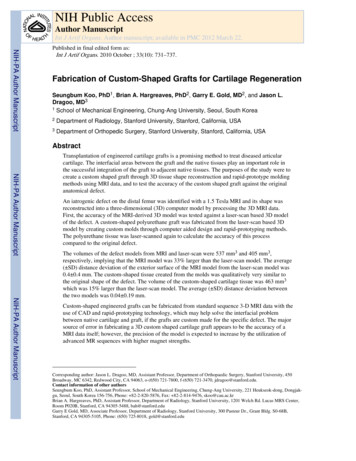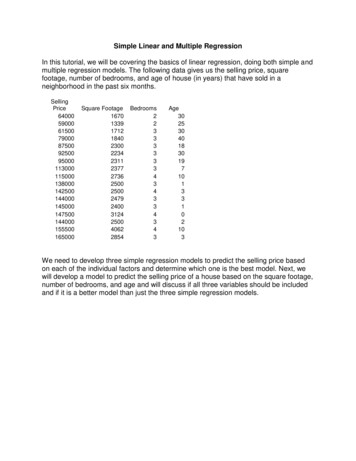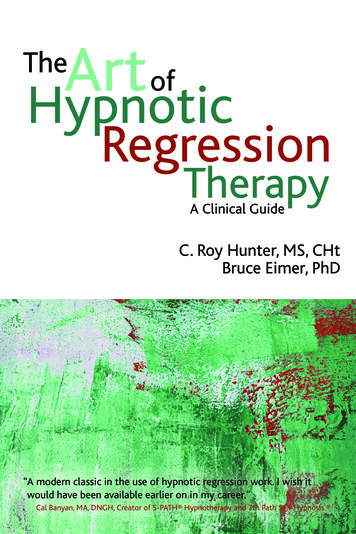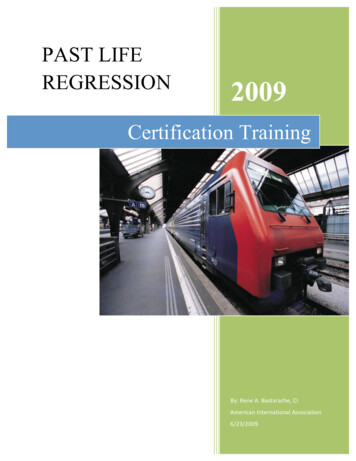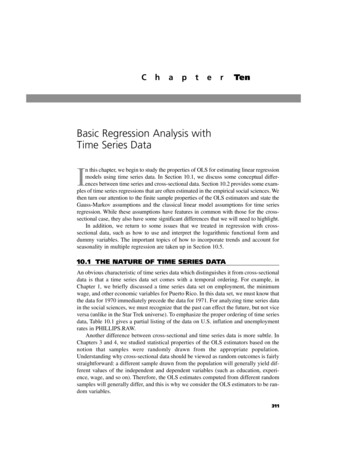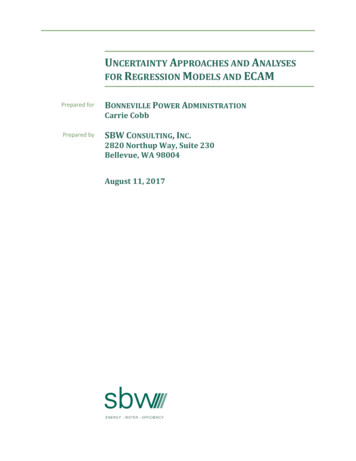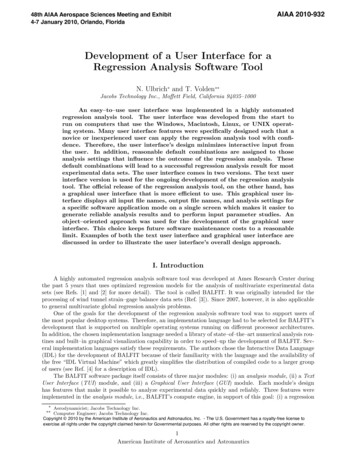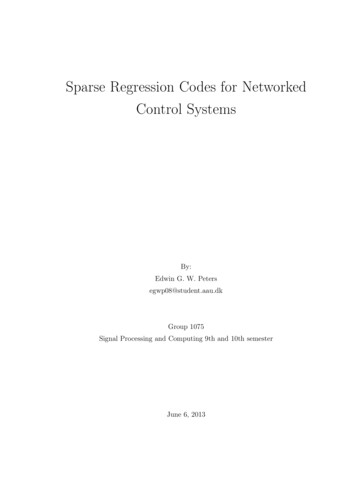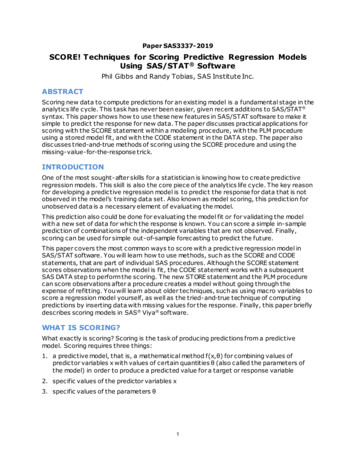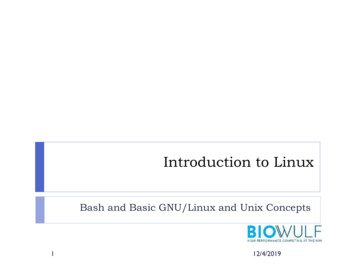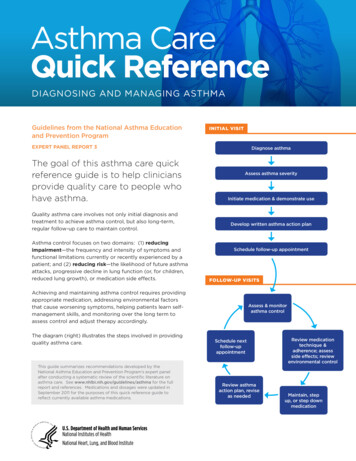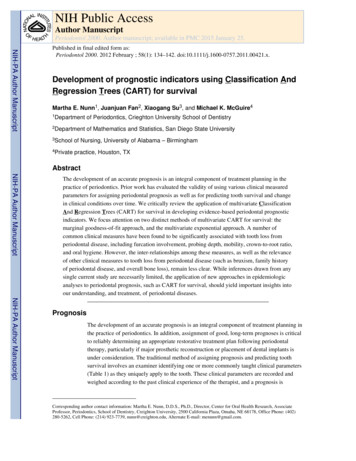
Transcription
NIH Public AccessAuthor ManuscriptPeriodontol 2000. Author manuscript; available in PMC 2015 January 25.NIH-PA Author ManuscriptPublished in final edited form as:Periodontol 2000. 2012 February ; 58(1): 134–142. doi:10.1111/j.1600-0757.2011.00421.x.Development of prognostic indicators using Classification AndRegression Trees (CART) for survivalMartha E. Nunn1, Juanjuan Fan2, Xiaogang Su3, and Michael K. McGuire41Departmentof Periodontics, Crieghton University School of Dentistry2Departmentof Mathematics and Statistics, San Diego State University3Schoolof Nursing, University of Alabama – Birmingham4Privatepractice, Houston, TXAbstractNIH-PA Author ManuscriptThe development of an accurate prognosis is an integral component of treatment planning in thepractice of periodontics. Prior work has evaluated the validity of using various clinical measuredparameters for assigning periodontal prognosis as well as for predicting tooth survival and changein clinical conditions over time. We critically review the application of multivariate ClassificationAnd Regression Trees (CART) for survival in developing evidence-based periodontal prognosticindicators. We focus attention on two distinct methods of multivariate CART for survival: themarginal goodness-of-fit approach, and the multivariate exponential approach. A number ofcommon clinical measures have been found to be significantly associated with tooth loss fromperiodontal disease, including furcation involvement, probing depth, mobility, crown-to-root ratio,and oral hygiene. However, the inter-relationships among these measures, as well as the relevanceof other clinical measures to tooth loss from periodontal disease (such as bruxism, family historyof periodontal disease, and overall bone loss), remain less clear. While inferences drawn from anysingle current study are necessarily limited, the application of new approaches in epidemiologicanalyses to periodontal prognosis, such as CART for survival, should yield important insights intoour understanding, and treatment, of periodontal diseases.NIH-PA Author ManuscriptPrognosisThe development of an accurate prognosis is an integral component of treatment planning inthe practice of periodontics. In addition, assignment of good, long-term prognoses is criticalto reliably determining an appropriate restorative treatment plan following periodontaltherapy, particularly if major prosthetic reconstruction or placement of dental implants isunder consideration. The traditional method of assigning prognosis and predicting toothsurvival involves an examiner identifying one or more commonly taught clinical parameters(Table 1) as they uniquely apply to the tooth. These clinical parameters are recorded andweighed according to the past clinical experience of the therapist, and a prognosis isCorresponding author contact information: Martha E. Nunn, D.D.S., Ph.D., Director, Center for Oral Health Research, AssociateProfessor, Periodontics, School of Dentistry, Creighton University, 2500 California Plaza, Omaha, NE 68178, Office Phone: (402)280-5262, Cell Phone: (214) 923-7739, nunn@creighton.edu, Alternate E-mail: menunn@gmail.com.
Nunn et al.Page 2NIH-PA Author Manuscriptassigned. Previous studies by McGuire [19.] and McGuire & Nunn [20., 21., 22.] haveevaluated the validity of using these clinical parameters for correctly assigning prognosisand predicting tooth survival and change in clinical condition over time. These papersconcluded that there was a relationship between many commonly used clinical factors andprediction of change in clinical status over time as well as tooth loss rate, although theability to predict future condition of a tooth varied by tooth type (i.e., molars vs. nonmolars). With respect to the relationship of commonly taught clinical parameters to toothloss rate, some clinical factors, such as satisfactory crown-to-root ratio, mobility status,furcation involvement, or heavy smoking, contributed significantly to predicting the rate oftooth loss while other clinical parameters, such as root form or patient age, demonstratedvery little relationship to the probability of tooth loss.NIH-PA Author ManuscriptMachtei et al. [17., 18.] evaluated both clinical parameters as well as certain immunologicaland microbiological parameters in predicting change in clinical status over time as well astooth loss. Baseline smoking status, cotinine level, mean probing depth, mean attachmentloss, and crestal bone height were all associated with bone loss over time as well asattachment loss over time, although the relationship to attachment loss was somewhat lessthan the relationship to bone loss. The presence of Bacteroides forsythus, Prevotellaintermedia, and Porphyromonas gingivalis were also associated with future periodontaldestruction [17.]. Baseline attachment loss, loss of crestal bone height, and various systemicconditions were associated with increased tooth loss over time while the presence of B.forsythus doubled the risk of tooth loss over time [18.].While our research has focused on the assignment of prognosis based on the relationship ofcommonly taught clinical factors to tooth loss, other research has investigated thedevelopment of criteria for assignment of periodontal prognosis based on radiographicalveolar bone loss. In one study by Horwitz et al. [12.], three radiographic measures werefound to be predictive of the healing of class II furcation involvement following surgicalintervention. In another study by Nieri et al. [24.] investigators examined subject-level,tooth-level, and site-level variables as predictors of alveolar bone loss over time. The mostsignificant predictors of alveolar bone loss over time were mean alveolar bone loss atbaseline with effect modification with the IL-1 genotype, tooth mobility, and site-levelalveolar bone height at baseline [24.].NIH-PA Author ManuscriptOne of the underlying premises of our series of papers [19., 20., 21., 22.] is that thetraditional method for assignment of prognosis involves a subjective process based oncommonly taught clinical parameters and a therapist’s experience and training. There is noestablished universal set of criteria for assignment of periodontal prognosis, and thus,different practitioners may assign varying prognoses for the same tooth, which can beproblematic to the referring dentists, third-party payment plans (e.g., dental insurancecompanies), and the patients themselves since instead of providing guidance to treatmentplanning, it creates further uncertainty. In order to remedy this situation, we embarked on along-term goal to establish objective criteria for assignment of prognosis based on actualoutcome. An essential step in pursuing this goal was to extend statistical methods used indevelopment of prognosis in various areas of medicine to the complexities of dental data.Periodontol 2000. Author manuscript; available in PMC 2015 January 25.
Nunn et al.Page 3Classification And Regression Trees (CART)NIH-PA Author ManuscriptNIH-PA Author ManuscriptThe idea of regression trees dates back to the automatic interaction detection program byMorgan & Sonquist [23.]. After the introduction of classification and regression trees(CART) by Breiman et al. [1.], tree-based methods attracted wide popularity in a variety offields because they require few statistical assumptions, handle various data structuresreadily, and provide for meaningful interpretation. Regression trees constitute a data miningtechnique that seeks to construct an optimum decision tree based on partitioning a set ofvariables to accurately predict a dichotomous outcome. The need to develop meaningfulassignment of prognosis in medical research led to the generalization of regression trees tosurvival analysis. Since survival analysis involves actual failure times in addition to failurestatus, the use of regression trees with survival analysis enables one to extract moreinformation from data compared with other analytical techniques, such as logisticregression. Existing methods for univariate survival trees generally fall into two groups: (1)The first group, analogous to CART, involves minimizing within-node variability in survivaltimes and is surveyed by Gordon & Olshen [10.], among others [6. 14. 27.]. (2) The secondgroup utilizes a goodness-of-split criterion that maximizes the difference in survival betweenchildren nodes as measured by a two-sample statistic, such as the log-rank statistic. Researchinto this second group is exemplified by Ciampi et al. [2.], Segal [25.], and LeBlanc &Crowley [15.]. Notable examples of application of CART for survival in the development ofprognosis for cancer include breast cancer where survival trees indicated that lymph nodestatus was the strongest predictor of relapse while the markers cathepsin D and PAI-1 werethe strongest predictors of relapse among those without lymph node involvement [11.], thinprimary cutaneous malignant melanoma where prognosis based on survival trees was moreaccurate in predicting metastasis after 10 years than staging developed by the AmericanJoint Commission on Cancer [9.], and development of prognostic categories based onrelapse for head-and-neck squamous cell carcinoma [13.].NIH-PA Author ManuscriptMultivariate failure time data can occur when either a subject experiences multiple failures(recurrent failures, such as restoration failures) or individuals under study are naturallyclustered (e.g., tooth loss) with two main approaches to multivariate survival. For naturallyclustered data, the marginal approach advocated by Liang et al. [16.] and Wei et al. [28.] isuseful. In the marginal approach, the marginal distribution of correlated failure times isformulated by a Cox proportional hazards model [5.] while the dependence structure isunspecified. Robust inference is made via the technique of estimating equations. The otherapproach that is particularly applicable to multiple failures is the frailty model first proposedby Clayton [3.] and later extended to the regression setting by Clayton & Cuzick [4.]. In thefrailty model approach, dependence is modeled explicitly via a multiplicative random effectterm called frailty, which corresponds to some common unobserved characteristics sharedby all correlated times.Recently, we extended the method of Classification And Regression Trees (CART) forsurvival to accommodate multivariate failure time data (7., 8., 26.), such as tooth loss andrestoration failure observed in dental research, by applying techniques for multivariatesurvival analysis to CART for survival. In this paper, we apply this newly developedextension of CART for survival to the data collected for 100 well-maintained periodontalPeriodontol 2000. Author manuscript; available in PMC 2015 January 25.
Nunn et al.Page 4NIH-PA Author Manuscriptpatients who were diagnosed with moderate-to-severe periodontal disease in order todetermine evidence-based criteria for assignment of prognosis based on commonly taughtclinical parameters.Analytic Approaches Using CART for Identifying Prognostic IndicatorsWe present here the methodologic approach that we have used successfully to apply CARTto patient-based data. As we have reported in our earlier papers, 100 consecutive patientswith at least 5 years of maintenance care were selected from one clinician’s appointmentbook over a 2-month period. All subjects included in the study had been initially diagnosedwith chronic generalized moderate to severe periodontitis and were treated by the sameclinician. The inception cohort was established at a fairly uniform point in their disease andall patients followed a similar course of treatment. Patients in this study were undermaintenance regimens of 2 or 3-month intervals with the majority under a 3-month intervaland followed for 10 to 18 years. Most patients were compliant and demonstrated reasonableoral hygiene. Additional information regarding the study population, therapy, limitations ofthe study and assignment of prognoses can be found in our initial reports [19., 20., 21.].NIH-PA Author ManuscriptUsing the method of Classification And Regression Trees for survival for correlatedoutcomes, we fit trees using both the marginal goodness-of-split approach and themultivariate exponential model with gamma frailty. A further description of thesetechniques can be found in our papers in the statistical literature [7., 8., 26.]. Based on treesfit with the marginal approach where the first split occurred on furcation involvement (0 vs.1, 2, 3), we stratified multivariate exponential survival trees by molars and non-molars.Trees were fit using programs developed in R statistical software.Use of CART to Identify Periodontal Prognostic IndicatorsNIH-PA Author ManuscriptThe analyses that we have reviewed and summarized here have included a total of 2509teeth from 100 well-maintained periodontal patients, from a private periodontal practice,with moderate-to-severe periodontitis. Data were collected using 22 clinical measures andwere considered for inclusion in all survival trees, as provided in Table 2. The first treeshown in Fig. 1 is for the marginal goodness-of-split approach [8.] that was applied to allteeth from the dataset. As can be seen from the tree, the significant clinical variables in thetree included furcation involvement, probing depth, crown-to-root-ratio, age at baseline,mobility, and average percent bone loss across the mouth. Table 3 shows how the marginalgoodness-of-split tree performed in terms of prediction. While the percent tooth loss foreach category increased with worse prognostic category, the lack of sensitivity in terms oflow tooth loss in the “Questionable” and “Hopeless” categories make this particular tree lessthan desirable in terms of prediction.Based on the first split on furcation involvement in the marginal goodness-of-split approach,further survival tree modeling was conducted with stratification by molars and non-molars.The best performance in terms of prediction was obtained from the multivariate exponentialsurvival trees which are shown in Figs. 2 and 3. Fig. 2 shows the final multivariateexponential survival tree for non-molars. As can be seen in Fig. 2, probing depth, untreatedbruxism (i.e., parafunctional habit without a biteguard), oral hygiene, mobility, removablePeriodontol 2000. Author manuscript; available in PMC 2015 January 25.
Nunn et al.Page 5NIH-PA Author Manuscriptabutment, and mean percent bone loss were all significant factors in the multivariateexponential survival tree for predicting tooth loss over time in non-molars. Fig. 3 shows thefinal multivariate exponential survival tree for molars. Based on Fig. 3, crown-to-root ratio,probing depth, furcation involvement, root form, untreated bruxism, oral hygiene, mobility,biteguard, mean percent bone loss, and family history of periodontal disease were allsignificant factors in the multivariate exponential survival tree. Table 4 summarizes theprognostic categories from the survival trees depicted in Figs. 2 and 3. Table 5 shows thepredictability of the multivariate exponential survival trees by molars vs. non-molars. As canbe seen from Table 5, sensitivity increased considerably with stratification by molars vs.non-molars, although optimal sensitivity was still not achieved. Fig. 4 shows the actualsurvival for predicted prognostic categories based on the stratified multivariate exponentialsurvival trees. As can be seen from the survival plot in Figure 4, sensitivity and specificityare relatively high for all categories.Implications for Clinical Research and PracticeNIH-PA Author ManuscriptNIH-PA Author ManuscriptCurrently, no uniform system for assignment of periodontal prognosis exists. Previousresearch has demonstrated that many commonly used clinical parameters are associated withthe probability of tooth survival [12., 17., 18., 19., 20., 21., 22.]. The purpose of this studywas to show the utility of multivariate CART procedures for survival in developing such asystem. We first applied multivariate CART for survival using a goodness of fit approach toa database consisting of 100 well-maintained patients in one private periodontal practice.However, sensitivity from the final tree was poor with less than a third of the teeth classifiedas “Hopeless” being lost (Table 3). Based on this initial tree with the first split on furcationinvolvement, with furcation of zero being a potential proxy for non-molars, we thenstratified further CART modeling by molars and non-molars. We then utilized multivariateexponential modeling and grew trees for molars and non-molars separately with much bettersensitivity and specificity obtained (Table 5), although results were still not optimal. Basedon stratified modeling, unsatisfactory crown-to-root ratio was the most predictive factor inmolar failure while probing depth greater than 5 mm was the most predictive factor in nonmolar failure. Other factors that were significantly associated with molar failure included:increased probing depth, increased mobility, increased furcation involvement, no familyhistory of periodontal disease, poor oral hygiene, and unsatisfactory root form. Other factorsthat were significantly associated with non-molar failure included: increased overall percentbone loss, poor oral hygiene, increased mobility, untreated bruxism, and being a removableabutment. While many of these factors make intuitive sense as predictors of tooth loss andare consistent across trees, other factors are inconsistent, such as the effect of untreatedbruxism on the survival of molars. For instance, molars in patients with a family history ofperiodontal disease and untreated bruxism had better tooth survival than molars in patientswith a family history of periodontal disease and no untreated bruxism (Fig. 3). Conversely,molars in patients without a family history of periodontal disease and untreated bruxism hadworse tooth survival than either categories with a family history of periodontal disease (Fig.3). Some of these inconsistencies is likely the result of a relatively small sample size, andsome may be the result of selection bias since the sample consisted entirely of well-Periodontol 2000. Author manuscript; available in PMC 2015 January 25.
Nunn et al.Page 6maintained periodontal patients with moderate-to-severe periodontitis in one periodontalpractice.NIH-PA Author ManuscriptWhile limited inference can be drawn from the models presented here since the patientswere taken from only one periodontal practice, the method applied demonstrates the utilityof this new statistical methodology in developing evidence-based periodontal prognosis. Inthe future, periodontal prognostic indicators based on survival trees built from data collectedfrom a large, heterogeneous population of patients from multiple practitioners may provide abetter basis for assignment of prognosis, and thus, treatment planning. The models presentedalso demonstrate that some common periodontal measures, such as probing depth, mobility,furcation involvement, crown-to-root ratio, and oral hygiene are significant predictors oftooth survival. In contrast, the role of some of common periodontal measures, such asuntreated bruxism, family history of periodontal disease, and overall percent bone loss, isnot so clear. More research in the area of periodontal prognosis, as well as overall dentalprognosis, needs to be conducted in order for practitioners to better assess the condition of atooth at any point in time and develop treatment plans that are better guided by evidencebased assignment of prognosis.NIH-PA Author ManuscriptThis study demonstrates the utility of multivariate CART for survival in development ofevidence-based prognostic indicators. Eventually, with the accumulation of longitudinal datafrom many practices, we should be able to develop evidence-based prognostic indicators thatcan be utilized by periodontists, dentists, third-party payment plans, an
assigned. Previous studies by McGuire [19.] and McGuire & Nunn [20., 21., 22.] have evaluated the validity of using these clinical parameters for correctly assigning prognosis and predicting tooth survival and change in clinical condition over time. These papers concluded that there was a relationship between many commonly used clinical factors and
